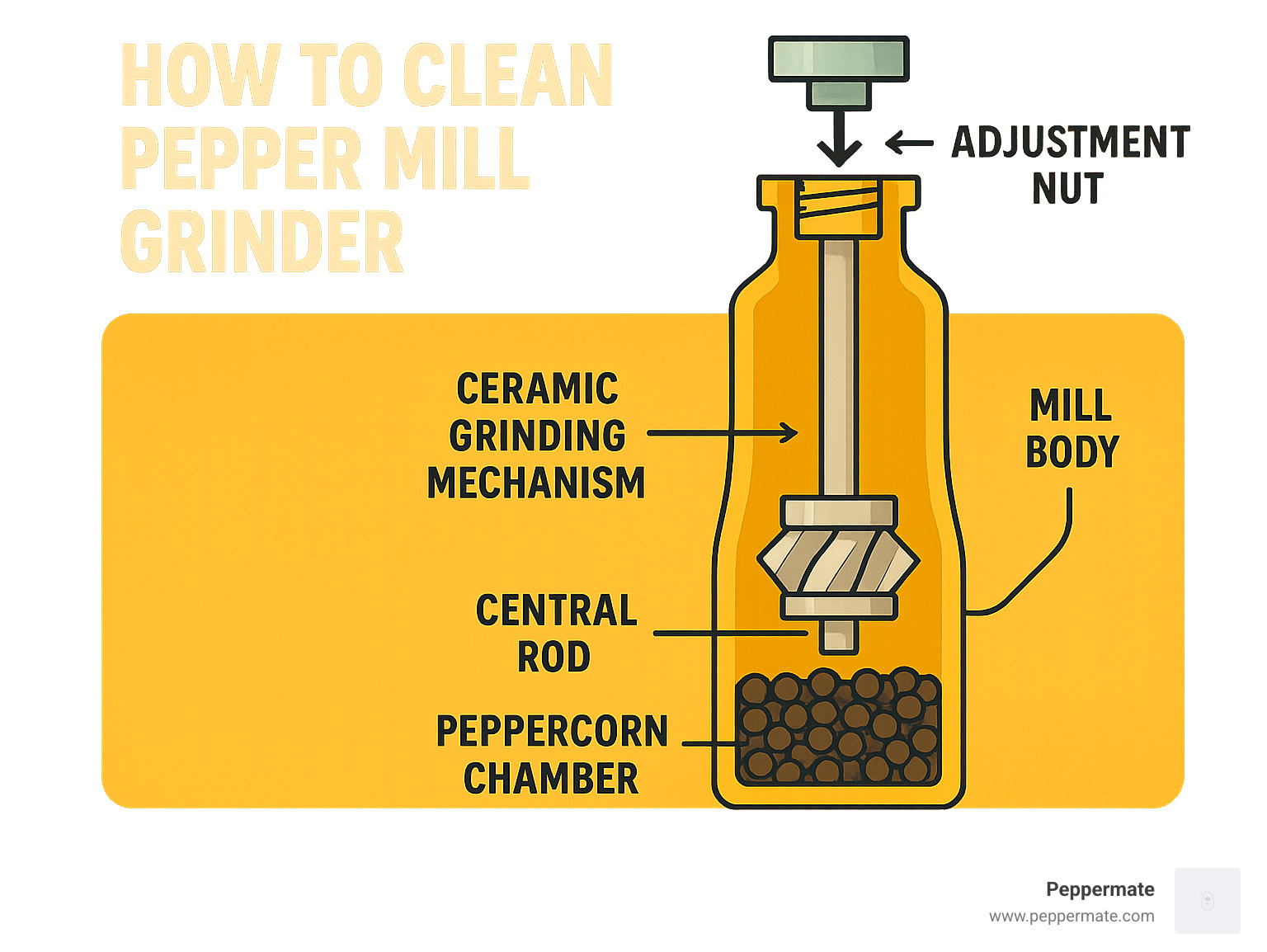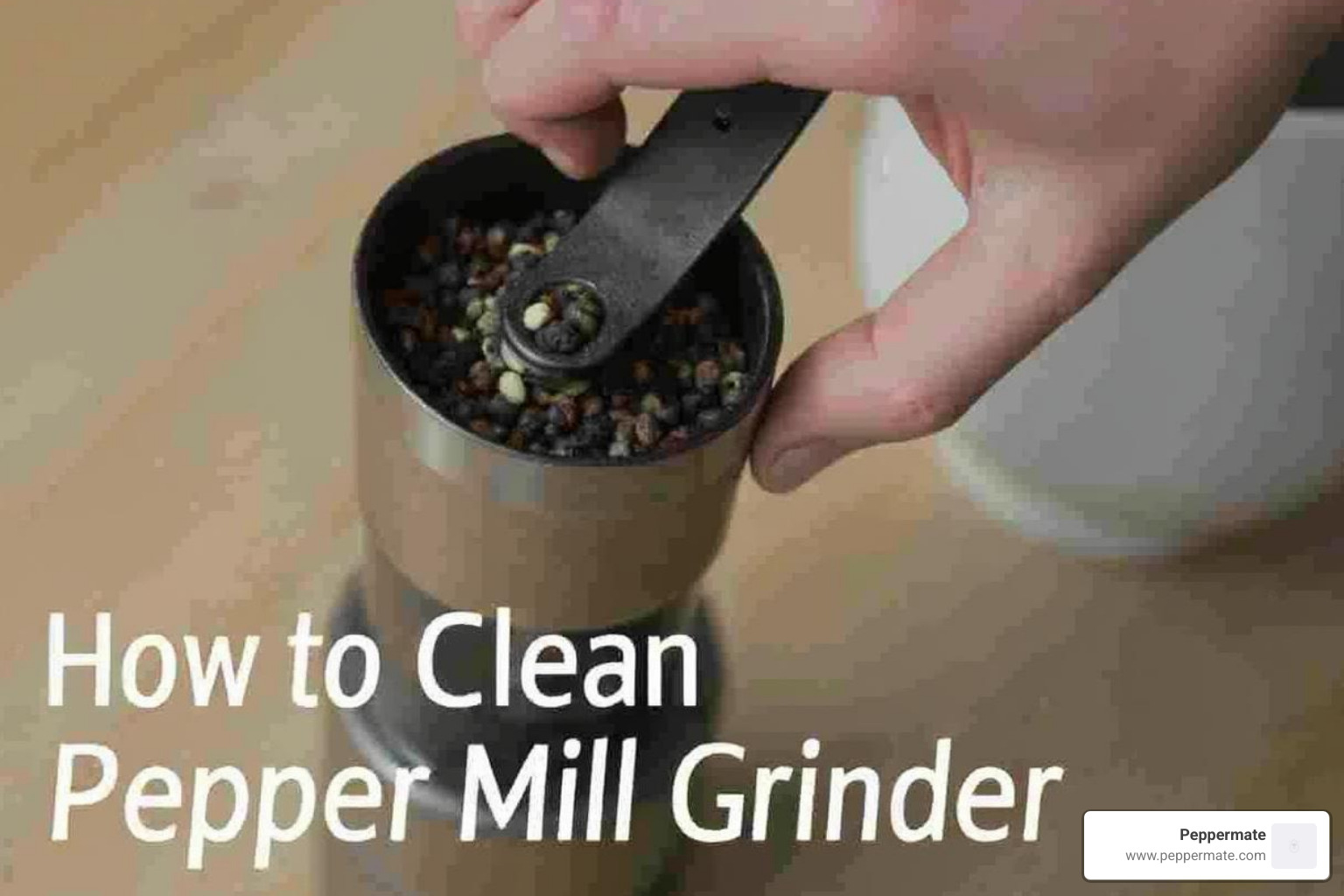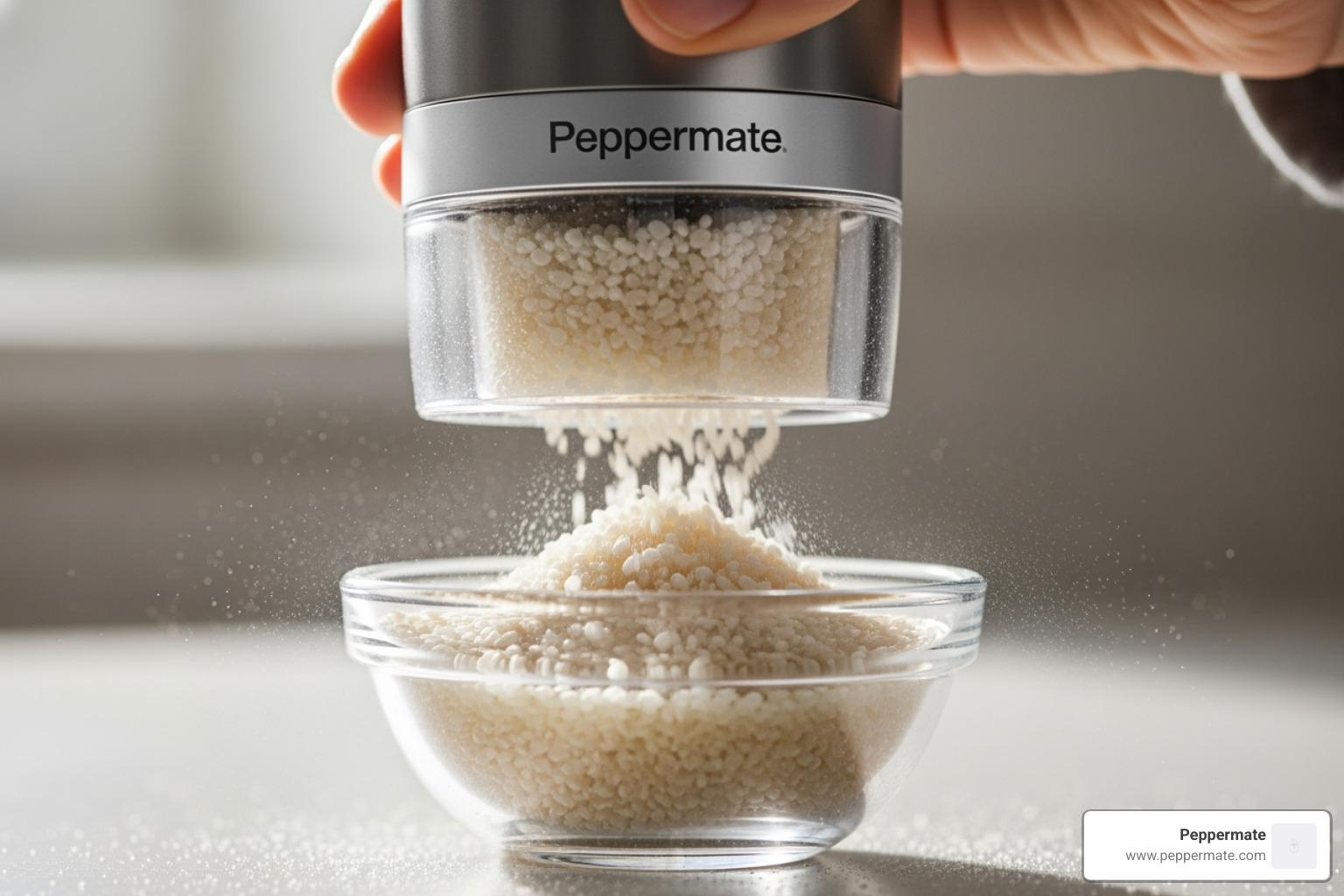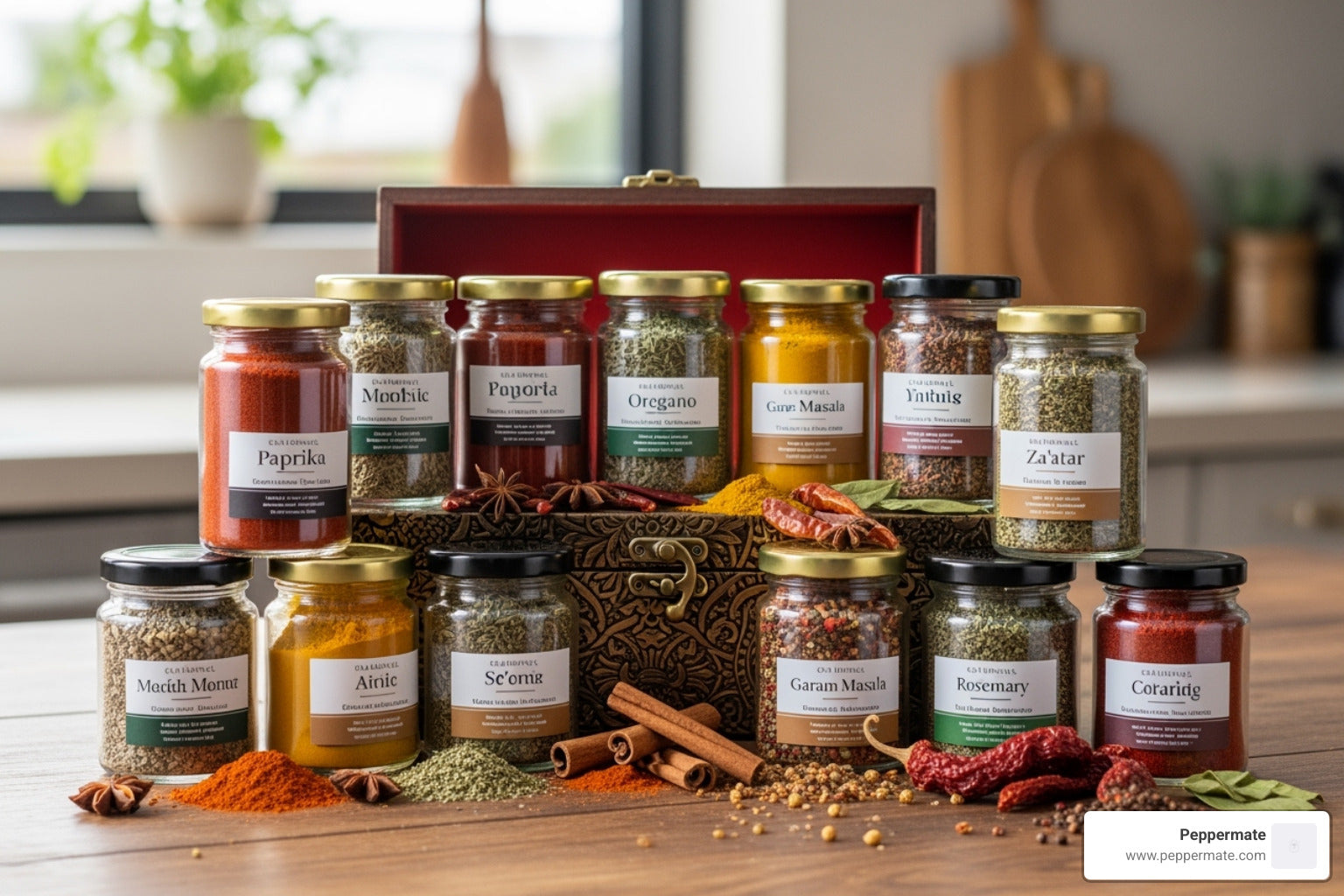Why a Clean Grinder Means Better Flavor
Learning how to clean pepper mill grinder properly is essential for maintaining fresh flavors and optimal performance. Over time, built-up oils and pepper dust can clog the mechanism, leading to inconsistent grinds and stale flavors.
Quick Cleaning Steps:
- Empty the mill completely.
- Disassemble by unscrewing the top nut and removing components.
- Clean mechanism by grinding 1-2 tablespoons of uncooked rice.
- Wipe body with a damp cloth and mild dish soap.
- Dry completely overnight before reassembly.
- Reassemble and test the grind adjustment.
Your pepper mill works by crushing peppercorns to release their essential oils. These oils, along with moisture from the air, gradually build up inside. Without regular cleaning, your grinder will produce inconsistent grinds, stale flavors, and may eventually stop working altogether. A clean grinder doesn't just work better—it delivers dramatically improved flavor.
I'm Joseph Rosenblatt PM, founder of a premium spice brand with years of experience in spice grinding and mill maintenance. Through developing spice blends and testing countless grinders, I've learned exactly how to clean pepper mill grinder mechanisms for peak performance and longevity.

How to clean pepper mill grinder definitions:
- automatic pepper mill grinder
- best ceramic spice grinder
- best pepper grinder mill
When and Why You Should Clean Your Pepper Mill
Even the best pepper mills need occasional cleaning to perform their best. Over time, natural oils and pepper dust build up inside the grinding mechanism, leading to several clear signs that it's time to learn how to clean pepper mill grinder.
Look out for these common issues:
- Inconsistent Grind Size: If you set your mill for a fine grind but get a mix of dust and large chunks, the mechanism is likely getting clogged.
- Clogged or Difficult to Turn: When oils and moisture combine, they can create a sticky paste that makes the mill hard to turn or seizes it up completely.
- Stale Flavors: Old, oily residue inside the mill can become rancid, imparting a bitter or musty taste to your fresh peppercorns.
- Changing Spices: A quick clean is essential when switching from one spice to another, such as from black pepper to white pepper or dried herbs. This prevents flavors from mixing.
- Moisture Buildup: Kitchen humidity can get inside your mill, and when mixed with pepper dust, it can create clogs or even mold. It's critical to keep the interior dry.
A little proactive maintenance goes a long way in keeping your Peppermate mill working beautifully and your flavors tasting fresh. For more perspectives on kitchen tool care, you can find expert advice on grinder maintenance from other professionals.
Prep Work: Tools and Materials You'll Need
Before you learn how to clean pepper mill grinder, gathering your tools will make the process smooth and simple. You likely have most of these items in your kitchen already.

Here are the tools and materials we recommend:
- Soft-bristled brush: A clean toothbrush or small pastry brush is perfect for dislodging pepper dust from the grinding mechanism.
- Microfiber cloths: Use these for wiping down all surfaces without leaving lint behind.
- Small bowl: Helpful for catching peppercorns and holding small, disassembled parts.
- Mild dish soap: For cleaning the exterior and, if needed, non-wood components. Avoid harsh solvents or detergents.
- Uncooked white rice: The best tool for dry cleaning the internal mechanism.
- Screwdriver (if applicable): Some mills require a Phillips-head or flathead screwdriver for disassembly. Check your specific model.
- Warm water: For dampening your cloth and rinsing washable parts.
Having everything organized beforehand ensures you won't misplace any crucial components.
Your Step-by-Step Guide on How to Clean a Pepper Mill Grinder
With your tools ready, it's time to clean your pepper mill. Follow these steps for a safe and effective cleaning. We recommend working on a soft cloth to prevent small parts from rolling away.

Step 1: Empty and Disassemble the Mill
The first step is to empty the mill and take it apart. This exposes the internal components where oils and dust accumulate.
- Empty the peppercorns: Pour any remaining peppercorns out of the chamber.
- Unscrew the top nut: This nut typically controls the grind size. Remove it to take off the top cap or handle.
- Disassemble the mechanism: Carefully pull the central rod and grinding mechanism out. On some models, a gentle tap may be needed.
- Keep all parts organized: Place all components—the top, rod, springs, and burrs—in a small bowl to prevent losing them.
Step 2: Clean the Grinding Mechanism
The grinding mechanism is the heart of your mill. There are two methods: a quick dry clean for regular maintenance and a deep wet clean for stubborn residue.
Method 1: The Dry-Clean (Recommended First)
Using uncooked white rice is the go-to method. It's safe for all Peppermate grinders, including our durable ceramic mechanisms, and avoids moisture.
- Add 1-2 tablespoons of uncooked white rice to the empty mill.
- Partially reassemble the mill so you can grind.
- Grind the rice through the mill. The rice will absorb oils and scrub away residue.
- Continue grinding until the rice comes out clean and white.

This quick, effective method is preferred because it prevents moisture issues that can lead to clogs or mold.
Method 2: The Deep Clean (If Necessary)
For very dirty mills, a deep clean with warm soapy water may be needed. This method is only for removable, non-wood grinding mechanisms, like our corrosion-resistant Peppermate ceramic burrs.
Warning: Do not use this method on the entire mill, especially wooden parts.
- With the mill disassembled, remove the grinding burrs.
- Use a soft-bristled brush to remove any loose dust.
- Gently wash the ceramic or metal burrs in warm water with a small amount of mild dish soap.
- Rinse the parts thoroughly to remove all soap.
- Set the parts aside to dry completely.
Our Peppermate ceramic mechanisms are versatile and non-corrosive. Learn more here: Why Choose a Peppermate Ceramic Pepper Mill.
Step 3: Clean the Mill's Body and Interior
Now, clean the rest of the mill, including the body and interior chamber.
- Exterior: Use a damp cloth with a touch of mild dish soap to wipe down the outside. Use a soft brush for hard-to-reach areas.
-
Material-Specific Care:
- Acrylic and Stainless Steel: These materials can be cleaned with a damp cloth. Wipe them dry immediately to prevent water spots.
- Wood: Be very careful with wood. Never submerge it in water. Use a barely damp cloth and wipe it dry immediately to prevent damage.
- Interior: A dry approach is best for the inside chamber. Use a dry, soft-bristled brush or a lint-free cloth to brush out any remaining pepper dust.
Step 4: The Crucial Drying Process
Thorough drying is the most important step. Any residual moisture can cause serious problems.
- Why It's Crucial: Moisture can cause rust on steel parts, promote mold growth, and make peppercorns clump, leading to clogs.
- How to Dry: After washing any parts, air dry them completely. Lay all components on a clean, dry towel in a well-ventilated area. We recommend drying them overnight to be safe.
- Avoid Towel Drying: Do not use a towel to dry internal mechanism parts, as it can leave behind lint that will interfere with the grinder's function. Air drying is the safest method.
Special Considerations and Common Mistakes
Understanding a few extra details and common pitfalls will help you master how to clean pepper mill grinder and keep your Peppermate in top shape.
Salt Mills vs. Pepper Mills
While they look similar, salt and pepper mills have different cleaning needs. Salt is corrosive and attracts moisture, which means salt mills are more prone to clogs. Our Peppermate ceramic mechanisms resist corrosion, but it's still a factor for the mill as a whole. You may need to clean your salt mill more frequently, and complete drying is even more critical to prevent caking. For more tips on caring for both, see our guide: Shake, Rattle, and Grind: The Ultimate Guide to Peppermate Ceramic Salt and Pepper Grinders.
Common Mistakes to Avoid
Knowing what not to do is just as important as knowing what to do. Avoid these common errors:
- Using water on non-washable parts: Never submerge or soak wooden components. For wood or electrical parts, stick to dry brushing or a slightly damp cloth.
- Not drying thoroughly: This is the most critical mistake. Incomplete drying leads to rust, mold, and clogs. Always air dry parts overnight.
- Submerging the entire mill: Do not dunk the whole unit in water. This can trap moisture and damage the mechanism.
- Using harsh chemicals or vinegar: Mild dish soap is all you need. Harsh cleaners can corrode parts, damage finishes, and leave a residue that taints your spices.
- Losing small parts: Disassemble your mill on a clear surface or over a tray. Keep all small nuts, washers, and springs in a bowl for easy reassembly.
Reassembly and Storage for Lasting Performance
Once your pepper mill grinder parts are clean and completely dry, it's time to reassemble. If you kept your parts organized, this will be simple.
Reassembly is the reverse of disassembly. Slide the central rod back into the body, then reattach the grinding burrs, springs, and washers. Place the top cap back on and screw on the top nut. The tightness of this nut controls your grind size.
After reassembly, test the grind. Add fresh peppercorns and give it a twist. It should turn smoothly. Adjust the top nut to your desired coarseness. The improved performance is the immediate reward for knowing how to clean pepper mill grinder properly.
Proper storage is key to keeping your mill in top condition. Store your mill in a dry place, away from humidity sources like a dishwasher or stovetop steam. Also, keep it away from direct heat and sunlight. A mill that is regularly used and kept filled with peppercorns often performs better than one left empty.
For more tips on choosing the right grinder, see our In-Depth Guide to Choosing the Best Peppermate Pepper Mills & Grinders.
Conclusion: Enjoy Fresh, Flavorful Grinds Every Time
You now know all the essential steps of how to clean pepper mill grinder. This simple maintenance routine open ups the full, vibrant flavor of your peppercorns and ensures your mill performs beautifully for years to come.
A clean grinder provides a consistent grind and fresh, aromatic pepper, elevating your entire cooking experience. It's a small investment of time for better flavor every day.
Our Peppermate grinders are crafted with high-quality, adjustable ceramic mechanisms and are designed for durability and ease of use. With our patented side handle and lifetime warranty, they are built to last. Armed with these cleaning tips, you have everything you need to keep your Peppermate working like new.
For more culinary tips and recipes, we invite you to explore our blog. Happy grinding!



